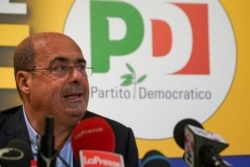Italy’s fragile coalition government breathed a collective sigh of relief Tuesday after voters denied the country’s populist leader Matteo Salvini the major electoral breakthrough he was seeking in hotly contested regional elections.
The center-left Democratic Party, PD, managed a comfortable victory in Tuscany, a region the left has ruled without interruption since regional governments were first elected in 1970, frustrating Salvini in taking the biggest prize in the elections for the governments of seven regions and a thousand towns and cities the length and breadth of Italy.
Tuscany is the buckle of the left’s so-called "red belt” and was targeted by Salvini’s populist Lega party. Salvini himself campaigned tirelessly in Tuscany in the run-up to the polls, predicting his party could win the wealthy region behind his handpicked candidate for the governorship, the telegenic 33-year-old Susanna Ceccardi, a former mayor.
With the regional counts still to be finalized Tuesday, the Democrats looked sure to hold three regions it ruled before. Along with Tuscany, incumbent PD governors were on course to win re-election in the southern regions of Campania and Apulia.
The leaders of the key government parties of Prime Minister’s Giuseppe Conte's coalition government, which is made up of the Democratic Party and the anti-establishment 5-Star Movement, M5S, along with some other smaller groups, were quick to celebrate Tuesday.
PD leader Nicola Zingaretti said, “We are very satisfied.” He said the result would facilitate further reforms and cooperation within the government.
And Luigi Di Maio, Italy’s foreign minister and a prominent member of M5S, said at a press conference: “Those that tried to transform this referendum into a vote against the government received a boomerang.” Eugenio Giani, the PD’s gubernatorial candidates in Tuscany, hailed his win an “extraordinary victory.”
But for all of the center-left’s jubilation, the PD lost a fourth region, Marche, where the far-right Brothers of Italy, part of a Lega-led center-right alliance, won the vote.
And the contest in Apulia in the heel of Italy was close.
The Lega-led center-right alliance held easily the three regions it was defending, including Veneto in the northeast, where incumbent Luca Zaia secured election as governor for the third time with an emphatically large majority. The size of his victory — he won 75% of the vote, largely due commentators say to his handling of the coronavirus pandemic — has prompted speculation that he might seek to challenge Salvini in the future for the leadership of the Lega. Zaia denies he has any plans to do so.
Jacopo Morrone, a Lega lawmaker, claimed the results overall are a victory for the populists, saying it was always going to be difficult to win Tuscany or Apulia “but to put them [the PD] in difficulty is a good result.”
The fact, though, that the Lega-led center-right opposition failed to land a knockout blow in the regional elections by winning the prize of Tuscany is being widely seen by analysts as strengthening Prime Minister Conte's shaky coalition government — at least in the short term.
Longer term, this week’s regional elections have confirmed that the Lega has managed to maintain a shift in the regional power balance further to the right nationally. Fourteen of the country’s 20 regions now are ruled by the Lega or its allies. A 15th could be added to the Lega tally. The votes of elections this week in the French-speaking Val d’Aosta, a tiny region in the north-east, remain to be counted, but exit polls suggest Lega-allies are likely to win there.
Pollster Lorenzo Pregliasco told reporters that this week’s regional elections should be considered a tie. “The PD had done a lot of expectation management, so that [the results] seem almost a victory, even if it is more of a draw,” he said. Other analysts say Salvini made a PR mistake with his pre-election forecasts that Lega would manage a victory in Tuscany.






